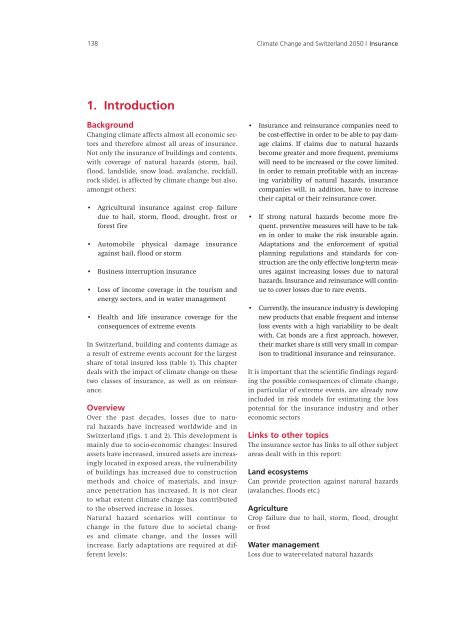Climate Change and Switzerland 2050 - OcCC - SCNAT
Climate Change and Switzerland 2050 - OcCC - SCNAT
Climate Change and Switzerland 2050 - OcCC - SCNAT
You also want an ePaper? Increase the reach of your titles
YUMPU automatically turns print PDFs into web optimized ePapers that Google loves.
138 <strong>Climate</strong> <strong>Change</strong> <strong>and</strong> Switzerl<strong>and</strong> <strong>2050</strong> | Insurance<br />
1. Introduction<br />
Background<br />
Changing climate affects almost all economic sectors<br />
<strong>and</strong> therefore almost all areas of insurance.<br />
Not only the insurance of buildings <strong>and</strong> contents,<br />
with coverage of natural hazards (storm, hail,<br />
flood, l<strong>and</strong>slide, snow load, avalanche, rockfall,<br />
rock slide), is affected by climate change but also,<br />
amongst others:<br />
• Agricultural insurance against crop failure<br />
due to hail, storm, flood, drought, frost or<br />
forest fire<br />
•<br />
•<br />
•<br />
•<br />
Automobile physical damage insurance<br />
against hail, flood or storm<br />
Business interruption insurance<br />
Loss of income coverage in the tourism <strong>and</strong><br />
energy sectors, <strong>and</strong> in water management<br />
Health <strong>and</strong> life insurance coverage for the<br />
consequences of extreme events<br />
In Switzerl<strong>and</strong>, building <strong>and</strong> contents damage as<br />
a result of extreme events account for the largest<br />
share of total insured loss (table 1). This chapter<br />
deals with the impact of climate change on these<br />
two classes of insurance, as well as on reinsurance.<br />
Overview<br />
Over the past decades, losses due to natural<br />
hazards have increased worldwide <strong>and</strong> in<br />
Switzerl<strong>and</strong> (figs. 1 <strong>and</strong> 2). This development is<br />
mainly due to socio-economic changes: Insured<br />
assets have increased, insured assets are increasingly<br />
located in exposed areas, the vulnerability<br />
of buildings has increased due to construction<br />
methods <strong>and</strong> choice of materials, <strong>and</strong> insurance<br />
penetration has increased. It is not clear<br />
to what extent climate change has contributed<br />
to the observed increase in losses.<br />
Natural hazard scenarios will continue to<br />
change in the future due to societal changes<br />
<strong>and</strong> climate change, <strong>and</strong> the losses will<br />
increase. Early adaptations are required at different<br />
levels:<br />
• Insurance <strong>and</strong> reinsurance companies need to<br />
be cost-effective in order to be able to pay damage<br />
claims. If claims due to natural hazards<br />
become greater <strong>and</strong> more frequent, premiums<br />
will need to be increased or the cover limited.<br />
In order to remain profitable with an increasing<br />
variability of natural hazards, insurance<br />
companies will, in addition, have to increase<br />
their capital or their reinsurance cover.<br />
• If strong natural hazards become more frequent,<br />
preventive measures will have to be taken<br />
in order to make the risk insurable again.<br />
Adaptations <strong>and</strong> the enforcement of spatial<br />
planning regulations <strong>and</strong> st<strong>and</strong>ards for construction<br />
are the only effective long-term measures<br />
against increasing losses due to natural<br />
hazards. Insurance <strong>and</strong> reinsurance will continue<br />
to cover losses due to rare events.<br />
• Currently, the insurance industry is developing<br />
new products that enable frequent <strong>and</strong> intense<br />
loss events with a high variability to be dealt<br />
with. Cat bonds are a first approach, however,<br />
their market share is still very small in comparison<br />
to traditional insurance <strong>and</strong> reinsurance.<br />
It is important that the scientific findings regarding<br />
the possible consequences of climate change,<br />
in particular of extreme events, are already now<br />
included in risk models for estimating the loss<br />
potential for the insurance industry <strong>and</strong> other<br />
economic sectors<br />
Links to other topics<br />
The insurance sector has links to all other subject<br />
areas dealt with in this report:<br />
L<strong>and</strong> ecosystems<br />
Can provide protection against natural hazards<br />
(avalanches, floods etc.)<br />
Agriculture<br />
Crop failure due to hail, storm, flood, drought<br />
or frost<br />
Water management<br />
Loss due to water-related natural hazards

















